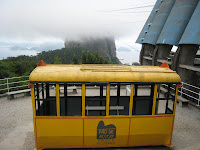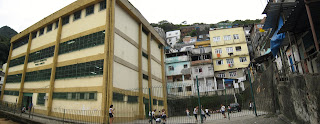

 When the Portuguese entered the bay of Rio, on January 1st 1502, on San Sebastian Day in the Portuguese calendar, they thought it was a river (rio in Portuguese). So they named it San Sebastian Rio de Janeiro!
When the Portuguese entered the bay of Rio, on January 1st 1502, on San Sebastian Day in the Portuguese calendar, they thought it was a river (rio in Portuguese). So they named it San Sebastian Rio de Janeiro!The French were actually the first settlers in the bay, establishing the colony of Antarctic France in 1555. But the Portuguese then defeated the French... Otherwise Brazilians would speak French!!!
The name “Brazil” comes from brazilwood, in which the Portuguese merchants expressed interest for its red dye.
During the 17th century African slaves replaced Indian prisoners on the sugarcane plantations. From 1550 until 1888 about 3.5 million slaves were shipped to Brazil.
“Fa” means black in African, “vela” means boat in Portguese : black people who came by boat.
Brazilians came from all over the country to find a job in the big cities. They settled in the mountains, creating the favelas.

How do the favelas work?
In favelas, people don´t pay water nor electricity. They just hook on the electric lines already existing for the rich (who pay double!).

 The companies don´t do anything as people are too scared to get shot. Each favela is governed by a political representative, and the chief of the mafia. Each favela tries to sell more drugs than the others, so they fight...
The companies don´t do anything as people are too scared to get shot. Each favela is governed by a political representative, and the chief of the mafia. Each favela tries to sell more drugs than the others, so they fight...A person from one favela cannot go to another favela, and when two people from different favelas fall in love... well, they meet at the beach :)
The average salary in Brazil is 450 reais (about 160 euros) per month. Gangsters can earn from 2,000 up to 1,000,000 for the chief. A young who decides to become a gangster knows that he will die young (25 years old in general). He sacrifices his life to make money for his family...
 The favela of Rocinha is 120 years old. 400,000 people live there. It is the biggest favela in South America, and one of the 815 favelas in Brazil.
The favela of Rocinha is 120 years old. 400,000 people live there. It is the biggest favela in South America, and one of the 815 favelas in Brazil.

It provides free education and many activities such as English classes, music, dance... and every year, a show is performed. The favela doing the best show gets 1 million reais!


The statue of the Christ is the largest art déco sculpture in the world. It is 38 m high! And it was sculpted by Paul Landowski, a Frenchman! It is one of the seven wonders of the world...
The history of Pão de Açùcar
According to historian Vieira Fazenda, the mountain was named Pão de Açùcar (Sugar Loaf) by the Portuguese. During the height of the sugarcane in Brazil during the 16th century, liquid sugar was placed to set in conical clay moulds, whose shape resembled that of the now famous mountain.
The Sugar Loaf Hill is 600.000.000 years old!
It is 396 meters high.


 View from the top!!!
View from the top!!!In 1907, Augusto Ferreira Ramos, an engineer, decided to build an aerial link between Red Beach, Urca Hill and Sugar Loaf Hill. The Sugar Loaf Cableway Company was founded in 1910, and became responsible for the building, operation and management of Sugar Loaf’s cable cars. Work started that same year. The cable car system was imported from Germany and assembled by local workers, who laboriously climbed the mountain and transported parts, motors and steel cables using a rudimentary winch. The work was completed in two years.
Thus in 1912, the first cable car system in Brazil and only the third in the world was inaugurated. The cablecar was covered by wood and transported some 7.890.511 tourists during the 60 years it was in operation.
In 1972, the current system was inaugurated, increasing the cable link’s capacity ten fold. The two lines have been duplicated and the new cable car – the only one in the world with two totally transparent sides – received a prestigious design award in Turim, 1971, for its unique diamond shape.
Known to be the one of the safest in the world, the Sugar Loaf cableway consists of four cable cars, two in Line 1 and two in Line 2.
 Each car has two track ropes and one traction cable. The entire system is electronically monitored and programmed; 47 separate safety features are checked before each departure.
Each car has two track ropes and one traction cable. The entire system is electronically monitored and programmed; 47 separate safety features are checked before each departure.From “ Caminho Aéreo Pão de Açùcar”
Watch the story of Pão de Açúcar
 The school.
The school.


No comments:
Post a Comment